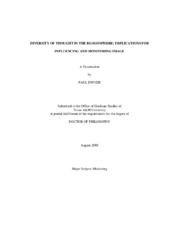| dc.description.abstract | A blog, a shortened form of weblog, is a website where an author shares
thoughts in posts or entries. Most blogs permit readers to add comments to posts and
thereby be a conversational mechanism. One way that companies have started to use
blogs is to monitor their corporate image (in this dissertation, the term image is used in
reference to corporate, brand and/or product image). This study focuses on how common
socio-psychological processes mediate consumers’ revelation of corporate image in the
blogosphere. Centering resonance analysis, a means of measuring similarity between
two bodies of text, is used in conjunction with multidimensional scaling to locate text as
cognitive objects in a space. Clusters are then detected and measured to quantify
diversity in the thoughts expressed. Detected patterns are studied from a social process
theory perspective, where complex phenomena are hypothesized to be the result of the
interaction of simpler processes. A majority of blog commenters compromise the expression of their thoughts to
gain social acceptance. This study identifies the most extreme of such people so
companies who monitor blogs can assign less weight to image indications gained from
them as they may be merely expressing thoughts that are intended to maintain social
acceptance.
It was also found that single-theme blogs attract a readership with similarly
narrow interests. The boldest and most diverse thinkers among comment writers have the
most impact because of their ability to provoke the thinking of others. However,
commenters who repeat the same ideas have little effect, suggesting that introducing
shills is unlikely to shift the sentiment of a blog’s readership.
People participate in blog communities for reasons (e.g., need for community)
that may undermine thought diversity. However, there may be value in serving those
needs even though no valuable insights are provided into image or directions for product
development. Members of homogeneous-thinking communities were observed to more
actively participate, with greater longevity. This may increase loyalty to the company
hosting the blog. | en |


